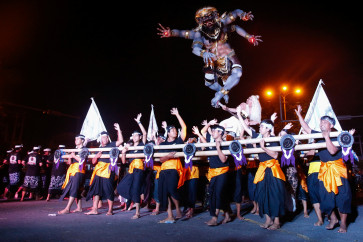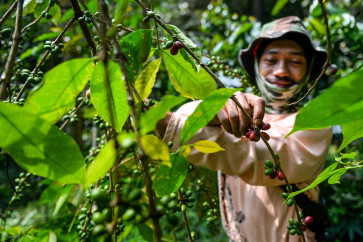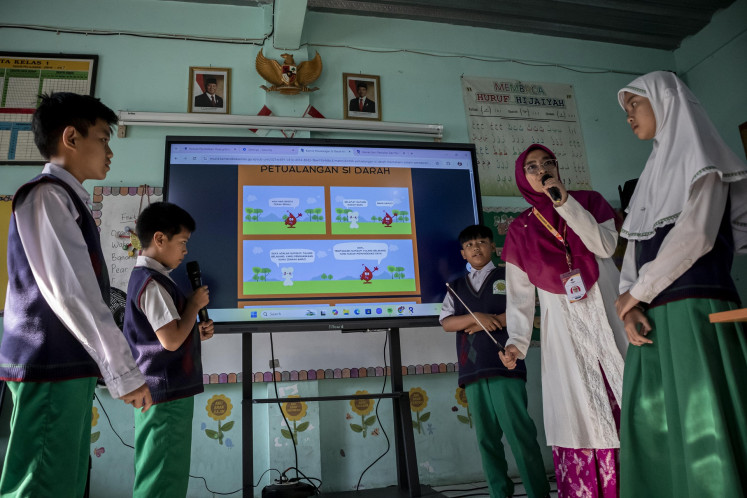Honeymoon Island: The hidden pearl of Lombok
Sekotong Beach resort in West Lombok, West Nusa Tenggara (NTB), is not as famous as the Senggigi coastal resort, or the Gili Trawangan, Gili Air and Gili Meno chain of islets in North Lombok regency
Change text size
Gift Premium Articles
to Anyone

S
ekotong Beach resort in West Lombok, West Nusa Tenggara (NTB), is not as famous as the Senggigi coastal resort, or the Gili Trawangan, Gili Air and Gili Meno chain of islets in North Lombok regency.
However, the chain of four islets off Sekotong are just as pristine. One of them is Gili Kedis. Among visitors this uninhabited island has gained the nickname “Honeymoon Island”. Some also call it “Romance Island”.
Gili Kedis is the smallest of the four islets in Sekotong. The other three are Gili Tangkong, Gili Nanggu and Gili Sudak.
“Most visitors to Gili Kedis are honeymooners,” tour guide Herry Sabwan said, while showing French tourists around Sekotong recently.
Gili Kedis is situated off the northwest coast of Lombok Island, around 50 kilometers from the provincial capital, Mataram. Administratively, the chain of islets is part of Tawun Village, Sekotong district, West Lombok.
Gili Kedis has an area of around 2.5 hectares. Viewed from Tawun Village on the mainland, Kedis looks like small coral island with dense foliage, surrounded by white sandy beaches.
It takes between 10 and 15 minutes to reach Gili Kedis by motorboat from Tawun jetty. Tourists usually make Kedis the last stop in their four-island trip.
“I am very glad I visited this island. It’s beautiful, peaceful and still pristine. I was also curious about why it is called Honeymoon Island,” said Julie Lendervez, 25, a French tourist travelling with her newly wedded husband, Vidre Wibowo, 27.
“It’s beautiful, peaceful and still pristine. I was also curious about why it is called Honeymoon Island.”
The couple, who got married three months ago, said they had set out to spend their vacation on the chain of islets off Sekotong Beach.
Julie and Vidre were among dozens of vacationeers at the islands last week. After checking out Gili Nanggu, Gili Tangkong and Gili Sudak, they visited Gili Kedis.
On Gili Nanggu, tourists could enjoy the natural and quiet atmosphere. The 12.5-hectare island also has an abundance of marine life, making it suitable for those who enjoy snorkeling or diving.
According to our tour guide, Tohri, visitors like to visit Gili Nanggu for its marine biota and friendly coral fish.
“A variety of fish in Gili Nanggu gather whenever there is food around, so visitors can see them closely,” he said.
From Gili Nanggu, the tourists visited Gili Sudak to have lunch. There is only one restaurant on the 18-hectare island, serving various seafood dishes.
“The local favourite is grilled fish, because we serve fresh fish from local fishermen,” restaurant operator Toto said.
Gili Sudak is beautiful, but perhaps not as stunning as Gili Nanggu.
After lunch, the group headed to Honeymoon Island. The trip took only five minutes from Sudak. When the tide is low, Honeymoon Island is accessible on foot from Gili Sudak, only around 200 meters away.
Given its natural beauty and tranquil atmosphere, Honeymoon Island befits its name, far from the hustle and bustle of the city.
Tourists visit the Sekotong islets almost every day, although not in big numbers, especially because it costs relatively little, at around Rp 300,000 (about US$30) for a motorboat tour.
“Tourists come here every day. They usually stay on Gili Kedis the longest, and only return in the evening,” said boat owner Mursan, in Tawun village.
Honeymoon Island is like a hidden treasure in Lombok, perhaps because promotion of the area by the local administration is not as constant as that for Senggigi and its three islands.
However, according to tour guide, Herry Sabwan, the Sekotong Islands were renowned among Europeans, including the French, Germans and Dutch.
Locals, however, bemoan the lack of public infrastructure there. Issues of waste management and facilities such as public toilets are still a challenge for the local administration.
“NTB administration initiated the Visit Sumbawa program in 2012, but how will tourists feel if when they come here garbage is still littered around and they have difficulty finding a toilet,” Herry said.
Herry cited Tawun jetty, the entrance to the Sekotong islets. Visitors often seemed neglected because there was no shelter for people waiting for boats. There were no public toilets either, so visitors had to use facilities of residents.
“These are probably trivial matters for the government, but they will give visitors a very bad impression.
While they may enjoy the natural environment, they also need comfortable facilities and services,” Herry said.









